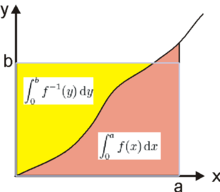Young's inequality
In mathematics, Young's inequality is either of two inequalities: one about the product of two numbers,[1] and one about the convolution of two functions.[2] They are named after William Henry Young.
Young's inequality for products can be used to prove Hölder's inequality. It is also used widely to estimate the norm of nonlinear terms in PDE theory, since it allows one to estimate a product of two terms by a sum of the same terms raised to a power and scaled.
Young's inequality for products
Standard version for conjugate Hölder exponents
In its standard form, the inequality states that if a and b are nonnegative real numbers and p and q are positive real numbers such that 1/p + 1/q = 1, then
Equality holds if and only if ap = bq. This form of Young's inequality is a special case of the inequality of weighted arithmetic and geometric means and can be used to prove Hölder's inequality.
Elementary case
An elementary case of Young's inequality is the inequality with exponent 2,
which also gives rise to the so-called Young's inequality with ε (valid for every ε > 0), sometimes called the Peter–Paul inequality .[3] This name refers to the fact that tighter control of the second term is achieved at the cost of losing some control of the first term – one must "rob Peter to pay Paul"
Standard version for increasing functions

 (red) and
(red) and  (yellow)
(yellow)For the standard version[4][5] of the inequality, let f denote a real-valued, continuous and strictly increasing function on [0, c] with c > 0 and f(0) = 0. Let f−1 denote the inverse function of f. Then, for all a ∈ [0, c] and b ∈ [0, f(c)],
with equality if and only if b = f(a).
Generalization using Fenchel-Legendre transforms
If f is a convex function and its Legendre transform (convex conjugate) is denoted by g, then
This follows immediately from the definition of the Legendre transform.
More generally, if f is a convex function defined on a real vector space  and its convex conjugate is denoted by
and its convex conjugate is denoted by  (and is defined on the dual space
(and is defined on the dual space  ), then
), then
where  is the dual pairing.
is the dual pairing.
Examples
- The Legendre transform of f(a) = ap/p is g(b) = bq/q with q such that 1/p + 1/q = 1, and thus Young's inequality for conjugate Hölder exponents mentioned above is a special case.
- The Legendre transform of f(a) = ea – 1 is g(b) = 1 − b + b ln b, hence ab ≤ ea − b + b ln b for all non-negative a and b. This estimate is useful in large deviations theory under exponential moment conditions, because b ln b appears in the definition of relative entropy, which is the rate function in Sanov's theorem.
Young's inequality for convolutions
In real analysis, the following result is also called Young's inequality:[6]
Suppose f is in Lp(Rd) and g is in Lq(Rd) and
with 1 ≤ p, q, r ≤ ∞. Then
Here the star denotes convolution, Lp is Lebesgue space, and
denotes the usual Lp norm.
An example application is that Young's inequality can be used to show that the heat semigroup is a contracting semigroup using the L2 norm (i.e. the Weierstrass transform does not enlarge the L2 norm).
In case p, q > 1 Young's inequality can be strengthened to a sharp form, viz
where the constant cp,q < 1.[7]
See also
Notes
- ↑ Young, W. H. (1912), "On classes of summable functions and their Fourier series", Proceedings of the Royal Society A 87 (594): 225–229, doi:10.1098/rspa.1912.0076, JSTOR 93236, Zbl 43.1114.12
- ↑ Young, W. H. (1912), "On the multiplication of successions of Fourier constants", Proceedings of the Royal Society A 87 (596): 331–339, doi:10.1098/rspa.1912.0086, JSTOR 93120, Zbl 44.0298.02
- ↑ Tisdell, Chris (2013), The Peter Paul Inequality, YouTube video on Dr Chris Tisdell's YouTube channel,
- ↑ Hardy, G. H.; Littlewood, J. E.; Pólya, G. (1952) [1934], Inequalities, Cambridge Mathematical Library (2nd ed.), Cambridge: Cambridge University Press, ISBN 0-521-05206-8, MR 0046395, Zbl 0047.05302, Chapter 4.8
- ↑ Henstock, Ralph (1988), Lectures on the Theory of Integration, Series in Real Analysis Volume I, Singapore, New Jersey: World Scientific, ISBN 9971-5-0450-2, MR 0963249, Zbl 0668.28001, Theorem 2.9
- ↑ Bogachev, Vladimir I. (2007), Measure Theory I, Berlin, Heidelberg, New York: Springer-Verlag, ISBN 978-3-540-34513-8, MR 2267655, Zbl 1120.28001, Theorem 3.9.4
- ↑ Fournier, John J. F. (1977), "Sharpness in Young's inequality for convolution", Pacific J. Math. 72 (2): 383–397, doi:10.2140/pjm.1977.72.383, MR 0461034, Zbl 0357.43002












